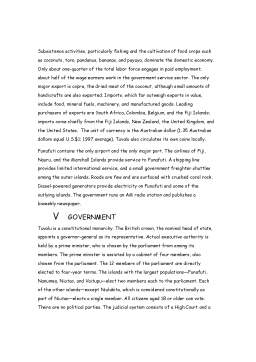Extras din referat
I INTRODUCTION
Tuvalu, small island country located in the western Pacific Ocean. Honalulu, Hawaii lies about 4,200 km (about 2,600 mi) to the northeast and Brisbane, on Australia's eastern coast, lies about 3,400 km (about 2,100 mi) to the southwest. Tuvalu’s nearest neighbors are Fiji, about 1,050 km (about 650 mi) to the south, and Samoa (formerly Western Samoa), about the same distance to the southeast. Formerly known as the Ellice Islands, Tuvalu was part of the British Gilbert and Ellice Islands Colony (GEIC) until it separated from the Gilberts (now Kiribati) in 1975 and achieved independence in 1978. It is a member of the Commonwealth of Nations, an association of nations that includes the United Kingdom and a number of its former dependencies. Fongafale, located on Funafuti Atoll, is the capital of Tuvalu.
II LAND AND RESOURCES
Tuvalu is a chain of nine low-lying coral islands, extending from northwest to southeast for about 600 km (about 400 mi). None of the islands has an elevation of more than 5 m (16 ft). Five of the islands—Funafuti, Nanumea, Nui, Nukufetau, and Nukulaelae—are atolls (a ring-shaped group of islands surrounding a central lagoon). The remaining islands—Nanumaga, Niutao, Vaitupu, and Niulakita—are single islands with smaller lagoons. Tuvalu has a total land area of 26 sq km (10 sq mi). Tuvalu’s exclusive economic zone (EEZ)—that is, the area of the surrounding ocean where it controls fishing and other rights—is about 910,000 sq km (350,000 sq mi).
Tuvalu has thin, sandy soil. Coconut trees thrive almost everywhere, but other vegetation is limited. Land animals are likewise limited. Rats, lizards, and turtles are the main wild animals; domesticated animals such as pigs, chickens, dogs, and cats also are found in Tuvalu. The surrounding waters contain a wide variety of fish, octopus, and crab. Because of Tuvalu’s porous soil, the only source of fresh water is rain collected in catchment systems.
The tropical climate of Tuvalu is warm and humid throughout the year, with an average annual temperature of about 30° C (about 86° F). Rainfall varies considerably from year to year and between the wetter southern islands and the drier northern islands. Average annual rainfall is about 3,000 mm (about 120 in). Tuvalu lies outside the major cyclone zone belt.
Like other low-lying Pacific countries, Tuvalu has expressed concern that sea levels could rise as a result of global warming. The United Nations listed Tuvalu as among the nations most at risk of complete submersion due to global warming. However, research has been inconclusive as to the likelihood and extent of an impending catastrophe.
III THE PEOPLE OF TUVALU
The population of Tuvalu was estimated at 10,444 in 1998, yielding an overall population density of 402 persons per sq km (1,040 per sq mi). About one-third of the people live on Funafuti in and around the capital; people continue to move there from the other islands in search of employment, thereby increasing governmental concerns about overcrowding there. About 1,000 Tuvaluans live and work overseas, particularly in the phosphate mining industry on Nauru.
Tuvaluans are almost all ethnic Polynesians. English and Tuvaluan, an Austronesian language, are the nation's official languages. Most people are bilingual, and literacy rates are high. Education is free and compulsory between the ages of 7 and 14. There are two high schools and a maritime training school. The University of the South Pacific operates an extension center on Funafuti. Some students pursue higher education overseas.
Most of the population belongs to the Congregationalist Church of Tuvalu, a Protestant church. Other Christian denominations are also represented. The Bahai and Islamic faiths have attracted a few converts in recent years. Social life centers around the church and family gatherings. Tuvaluans value harmonious social relations and modesty. Residents of the islands away from the capital live in traditional houses with raised foundations, open sides, and thatched roofs. On Funafuti, concrete block structures have largely replaced traditional buildings. Most of the people wear Western-style, casual clothing. Imported foods are popular, especially on Funafuti. Because fresh water is scarce, coconut milk is an essential beverage.
Preview document
Conținut arhivă zip
- Tuvalu Island.doc















